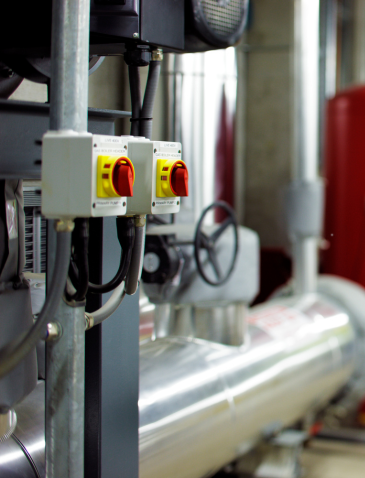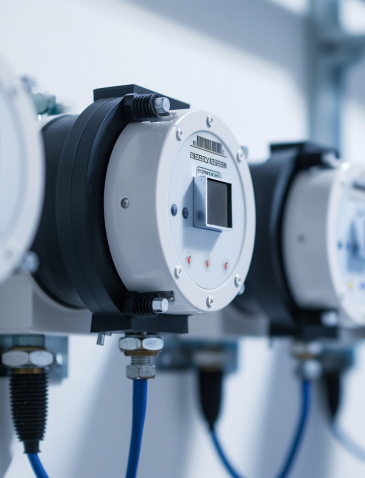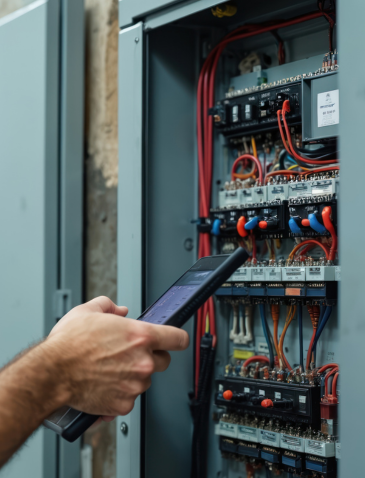Heat Interface Units (HIUs) are the unsung heroes of communal and district heating systems. They act as the bridge between a centralised energy centre and individual dwellings, delivering heating and hot water safely, efficiently and reliably.
With Ofgem’s regulatory oversight now in motion and the Heat Network Technical Assurance Scheme (HNTAS) on the horizon, choosing the right HIU and control strategy is more important than ever. Poor selection can result in inefficiencies, high running costs, resident complaints, and potential non-compliance.
This blog will explore the key types of HIUs, the difference between direct and indirect configurations, and how to approach selecting the right unit and control logic for your scheme, whether it’s a new build or retrofit.
Direct vs Indirect HIUs
The first step in HIU selection is determining whether a direct or indirect unit is appropriate.
Direct HIU
- The primary heating circuit directly feeds the radiators within the apartment
- Domestic hot water (DHW) is generated via a heat exchanger
- Typically lower cost and more compact
- Simpler hydraulics and controls
Indirect HIU
- Both heating and DHW are generated through heat exchangers
- Full hydraulic separation between the primary and secondary circuits
- More suited for high-rise buildings or networks with variable pressures
When to use which?
- Direct HIUs are commonly used in low-rise developments where system pressure and water quality can be tightly controlled
- Indirect HIUs are preferred for retrofit schemes, mixed-use buildings, or where full separation is required for safety and system stability
When comparing HIUs, there are several components and characteristics to evaluate:
1. Plate Heat Exchangers (PHE):
-
Determines efficiency and DHW response time
-
Larger surface area often improves heat transfer but must be balanced with space constraints
2. Control Valves:
- Motorised valves are more accurate but may increase cost and maintenance
- Thermostatic controls offer simplicity but less responsiveness
3. Sensors and Actuators:
- Quality sensors improve temperature stability and data accuracy
- M-Bus or Modbus compatibility is crucial for data collection
4. Flow Control:
- Modulating vs fixed modulating improves efficiency but requires robust controls
- Differential pressure control maintains consistent delivery across changing conditions
5. Prepayment Integration:
- Some HIUs are built with space or ports for prepayment devices
- Important for schemes where energy billing is recovered via credit systems
6. Mounting and Accessibility:
- Front-facing components and removable plates aid future servicing
- Compact design is key for small utility cupboards
HIU Control Strategies
Control strategy is just as critical as physical design. Even the best HIU won’t perform well with poor logic.
Common Control Strategies
1. Proportional Control (P):
- Adjusts valve position based on error signal only
- Simple but may lead to instability
2. Proportional-Integral (PI):
- Adds integral correction for steady-state error
- Good for maintaining setpoint over time
3. Proportional-Integral-Derivative (PID):
- Adds derivative correction to anticipate future trends
- More sophisticated but requires tuning
4. Weather Compensation:
- Adjusts flow temperature based on outside temperature
- Reduces energy consumption and improves resident comfort
5. Demand-Based Logic:
- Only opens the primary circuit when demand is detected
- Reduces standing losses and improves return temperatures
Performance vs Cost
Cost is always a factor, but cheapest rarely means best value in the long term.
When comparing HIUs, consider:
- Total cost of ownership (maintenance, repair, access)
- Long-term reliability (pump performance, valve quality)
- Resident experience (response time, noise, control)
- Data integration (ability to read consumption, monitor faults)
Remember: a £100 saving per unit may result in thousands lost in inefficiencies over a 10-year lifecycle.


Retrofit Considerations
In retrofit projects, physical constraints often dictate what can and can’t be done.
Common issues:
- Pipework doesn’t match new HIU layout
- No mains cold feed nearby
- Insufficient cupboard space
- Legacy wiring for valve control
Solutions include:
- Using adaptable mounting rails
- Selecting HIUs with flexible connections
- Pre-wired HIUs for simple swap outs
- Choosing compact or vertical models
Also, consider if the old system was direct and the new HIU is indirect, you may need isolation and flushing protocols to protect the new equipment.
Case Study:
New Build with Developer-Specified Wireless M-Bus
Situation:
A developer installed wireless M-Bus meters for data collection in a low-rise new build. Part-way through the project, the requirement changed to include prepayment functionality.
Problem:
Wireless M-Bus is not suitable for prepayment due to its limitations in real-time communication and responsiveness.
Solution:
Utilised the existing heat meters’ hard-wired M-Bus capability and installed a LoRaWAN-based prepayment device. This allowed full integration without replacing the meters and ensured compliance with modern prepayment infrastructure.


Case Study:
Legacy Site with Closed Protocol Equipment
Situation:
An older heat network was fitted with a closed protocol HIU and proprietary data collection system. The equipment provider has since ceased operations, leaving no access to resident consumption data.
Problem:
With no access to data, residents were left in the dark, unable to verify usage or understand charges. This represents the worst-case scenario for billing and transparency.
Solution:
A full replacement of the HIUs and data collection system was specified. The new solution is fully open protocol, ensuring any future billing provider can export data and serve residents fairly and transparently.
Case Study:
Ongoing Consultation in a Mixed-Use Development
Situation:
In a mixed-use scheme combining residential and commercial tenants, peak demand and load profiles vary significantly across zones.
Problem:
The goal was to optimise energy delivery without over-engineering the system.
Solution:
Engaged early with the developer to design a split approach, indirect HIUs with PID control and M-Bus metering for residential units, and dedicated plate heat exchangers with smart metering for commercial units. This ensured balanced loads and simplified ongoing energy management.


With HNTAS on the horizon, choosing an HIU that supports data visibility, efficiency, and control is essential.
Checklist for future-proofing:
Is it M-Bus or Modbus enabled?
Can it integrate with prepayment?
Does it support modulating controls?
Are the PHEs removable and serviceable?
Is there an option for firmware or logic updates?
Also consider your installer’s familiarity with the unit, poor installation can undo even the best hardware.
Design Stage Collaboration with Developers
One of the most overlooked opportunities in heat network projects is early-stage consultation. Working closely with developers at the design stage ensures the HIUs and control systems specified are:
Working closely with developers at the design stage ensures the HIUs and control systems specified are:
- Aligned with current testing standards (e.g. BESA HIU Test Regime, 2022)
- Compatible with the future expectations of HNTAS
- Designed for integration with modern data collection platforms
Early consultation helps avoid costly redesigns, delays, and retrofits. It also ensures cupboard space, riser layouts, and system zoning are considered before the building reaches the construction stage.


Data Collection is Not an Afterthought
Data collection should no longer be seen as a bolt-on. With Ofgem regulation approaching, it’s become a core requirement. Networks must demonstrate performance, prove fairness, and resolve disputes and none of that is possible without reliable, accessible data.
This means specifying:
- Meters with native M-Bus or LoRaWAN output
- HIUs with integrated data ports or pulse modules
- Centralised loggers and gateways with remote access
By placing data collection at the forefront, developers not only protect themselves from future compliance issues but also empower operators and billing providers to deliver a better resident experience.
Final Thoughts
The right HIU is more than just a box with valves. it’s a critical part of your heat network’s performance.
By understanding the differences between models and control strategies, and by engaging early with developers and data partners, you can avoid costly inefficiencies, reduce resident complaints, and meet the upcoming standards being introduced by Ofgem and HNTAS.
At Data Energy, we work with multiple manufacturers and control partners to specify HIUs that work, not just on paper, but in the real world.
Stay tuned for more breakdowns, or get in touch if you’re unsure what HIU is right for your scheme.
Got a Heat Network Challenge? Ask Daniel.
Have a question you’d love to see covered in a future post? Submit it below and Daniel might just take it on.
If you found this useful, we’re just getting started.
Subscribe for future insights from our Technical Project Consultant, Daniel Davies – tackling the real-world challenges of compliance, performance and fair billing.


